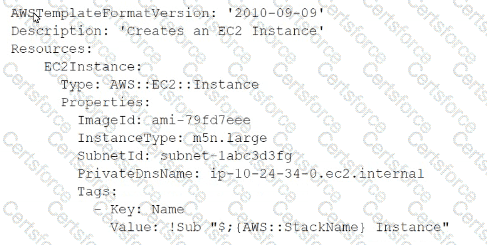A SysOps administrator developed a Python script that uses the AWS SDK to conduct several maintenance tasks. The script needs to run automatically every night.
What is the MOST operationally efficient solution that meets this requirement?
A company has developed a service that is deployed on a fleet of Linux-based Amazon EC2 instances that are in an Auto Scaling group. The service occasionally fails unexpectedly because of an error in the application code. The company's engineering team determines that resolving the underlying cause of the service failure could take several weeks.
A SysOps administrator needs to create a solution to automate recovery if the service crashes on any of the EC2 instances.
Which solutions will meet this requirement? (Select TWO.)
A SysOps administrator is examining the following AWS CloudFormation template:

Why will the stack creation fail?
A global company operates out of five AWS Regions. A SysOps administrator wants to identify all the company's tagged and untagged Amazon EC2 instances.
The company requires the output to display the instance ID and tags.
What is the MOST operationally efficient way for the SysOps administrator to meet these requirements?
To automatically reboot an EC2 instance when disk usage reaches 100%, a solution with minimal operational overhead is needed.
Options:
A SysOps administrator configures an Amazon S3 gateway endpoint in a VPC. The private subnets inside the VPC do not nave outbound internet access. A user logs in to an Amazon EC2 instance in one of the private subnets and cannot upload a file to an Amazon S3 bucket in the same AWS Region
Which solution will solve this problem?
A company has an application that uses Amazon DynamoDB tables The tables are spread across AWS accounts and AWS Regions. The company uses AWS CloudFormation to deploy AWS resources.
A new team at the company is deleting unused AWS resources. The team accidentally deletes several production DynamoDB tables by running an AWS Lambda function that makes a DynamoDB DeleteTable API call. The table deletions cause an application outage
A SysOps administrator must implement a solution that minimizes the chance of accidental deletions of tables. The solution also must minimize data loss that results from accidental deletions.
Which combination of steps will meet these requirements? (Select TWO.)
A SysOps administrator needs to automate the invocation of an AWS Lambda function. The Lambda function must run at the end of each day to generate a report on data that is stored in an Amazon S3 bucket.
What is the MOST operationally efficient solution that meets these requirements?
A SysOps administrator is troubleshooting connection timeouts to an Amazon EC2 instance that has a public IP address. The instance has a private IP address of 172.31.16.139. When the SysOps administrator tries to ping the instance's public IP address from the remote IP address 203.0.113.12, the response is "request timed out." The flow logs contain the following information:
What is one cause of the problem?
A company has an application that runs behind an Application Load Balancer (ALB) in the us-west-2 Region. An Amazon Route 53 record set contains an alias record for app.anycompany.com that references the ALB in us-west-2 and uses a simple routing policy. The application is experiencing an increase in users from other locations in the world. These users are experiencing high latency.
Most of the new users are close to the ap-southeast-2 Region. The company deploys a copy of the application to ap-southeast-2. A SysOps administrator must implement a solution that automatically routes requests to the lowest latency endpoint for users without changing the URL.
Which solution will meet these requirements?